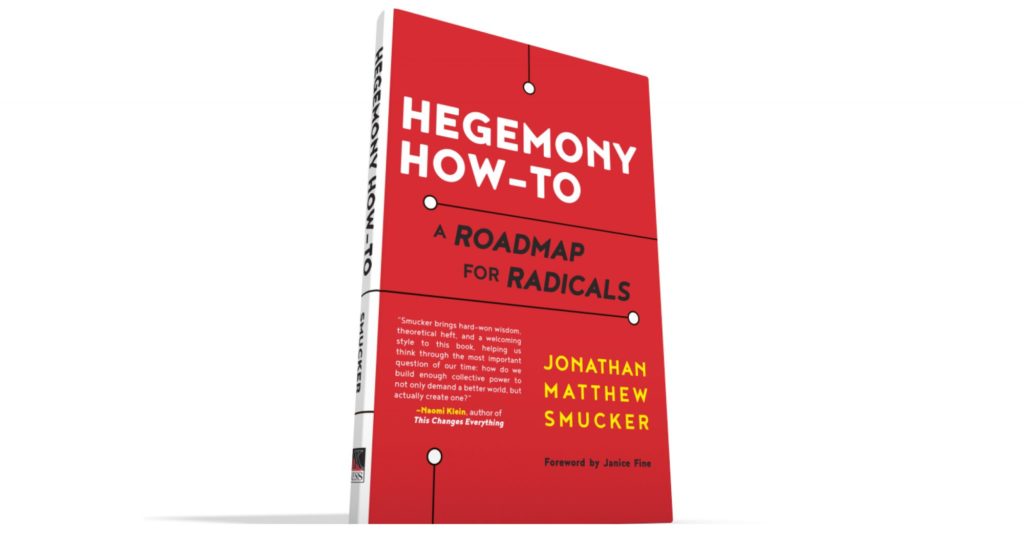By Wayne Price, Anarkismo
Review of Jonathan M. Smucker, Hegemony How-To: A Roadmap for Radicals
How can we build an effective popular movement to change society? That is the subject of this book, which has been widely praised. In my opinion, it has important and profoundly true things to say, but is politically unbalanced and mistaken in certain ways.
Smucker’s message is essentially this: too much of the Left is inward-looking, comfortable with itself, and self-involved. It is correct, even essential, to have a core group of reliable militants, but leftists must reach out to others, go beyond their comfort zone, and get other people involved, to whatever degree they can be involved. It is not enough to build a club of the like-minded. It is necessary to work out a strategy for winning gains, for influencing others, for achievement, and for exercising power. The strategic aim should be to challenge the dominance (the “hegemony”) of the ruling elite over popular consciousness and established institutions—and to ultimately replace its hegemony with that of the left.
Prefiguration vs. Strategy
The problem of the self-enclosed and isolated grouping applies in many forms on the left. It applies to small revolutionary socialist organizations, built around their dogmas and their newspapers. It applies to co-op stores and bicycle clubs. But Smucker is especially aiming his criticism at anarchists based on his experience in OWS encampment in 2011. He describes the anarchists as focused on building a self-governing collectivity, which would inspire people to go and do likewise. They did not, he claims, think of OWS in strategic terms, about how to use it as a basis for building a broader movement to challenge established politics. He counterposes the anarchist emphasis on “prefigurative” organizing to his focus on “strategic” thinking.
For example, David Graeber has written, “most successful forms of popular resistance have historically taken the form not of challenging power head on, but of ‘slipping away from its grasp,’ whether by means of flight, desertion, or the founding of new communities.” Laurence Davis summarizes—favorably—this viewpoint, “For contemporary ‘small-a’ anarchists … these here-and-now alternative institutions … and social relationships … are the essence of anarchism … Many contemporary anarchists insist that ‘the revolution is now.’” Some autonomous Marxists have adopted a similar perspective, calling it “exodus”—somehow escaping from capitalism without confronting it or the state.
Most of Smucker’s criticism is on the mark. The capitalist class with its institutions of power—especially the state—will not allow the people to gradually and peacefully build alternate institutions which could replace the market, industrial capitalism, and the national state. This was demonstrated (once again) when the police broke up Occupy encampments after a few months. This was done throughout the country, with coordination by the (Obama-Democratic Party) national government.
 But the opinions he cites are from only one school of anarchism. There is also the tradition of revolutionary class-struggle anarchism (libertarian socialism). This aims to build a mass movement which can eventually overthrow the capitalist class and its state, along with all other institutions of oppression—and replace them with self-managed, cooperative, institutions from below. It sees a major role for the working class which has the potential power to stop the means of production. It also has organized other sections of the oppressed and exploited to fight for freedom in various countries and at various times.
But the opinions he cites are from only one school of anarchism. There is also the tradition of revolutionary class-struggle anarchism (libertarian socialism). This aims to build a mass movement which can eventually overthrow the capitalist class and its state, along with all other institutions of oppression—and replace them with self-managed, cooperative, institutions from below. It sees a major role for the working class which has the potential power to stop the means of production. It also has organized other sections of the oppressed and exploited to fight for freedom in various countries and at various times.
Smucker, who claims to have once been an anarchist, appears to be completely ignorant of this alternate and mainstream tendency in anarchism which goes back to Bakunin and Kropotkin, the anarchist-communists and the anarcho-syndicalists. An example of this is his discussion of recent biological evidence that human beings, like other animals, are not only competitive and aggressive, but also are highly cooperative and sociable. This is true, but it was demonstrated over a century ago by Peter Kropotkin in his Mutual Aid, a foundational work for anarchism.
Revolutionary anarchism would not accept this binary counterposition of prefiguration vs. a strategy for power. Even Smucker accepts that a strategic approach may incorporate prefiguration, as a minor aspect. But actually the two depend on each other. We cannot build a participatory democratic society unless we build a participatory democratic movement, and it will be a stronger movement the more that people democratically participate.
The Limits of Liberalism
The primary weakness of this book is its one-sided focus on sectarian withdrawal and self-involvement on the left. The main problem with the left is not self-involvement but liberalism, reformism, and opportunism. From the ‘30s to today, most of the Left has supported—or at least, accommodated—capitalism, only urging better regulation of business by the state. It has promoted the state as the main remedy for all social evils—if only the state would be somewhat more democratic. It has portrayed the state as a neutral institution, to be used by the corporate rich or by working people. It has urged a focus on elections and channeled mass action into the Democratic Party, the “party of the people,” which has consistently been the swamp in which movements suffocate and die. This has been true not only of liberals but also of most of those calling themselves “socialists” or “communists.”
The liberal approach has led to victories, but none which have remained stable and reliable especially since the period of stagnation and decline [neo-liberalism] beginning about 1970.
So while Smucker strongly criticizes self-enclosed, sectarian, anarchists and others, he has barely a few phrases about the danger of being coopted by ruling powers. He hopes to build a broad popular movement, including large numbers of “ordinary people,” workers of all sorts, students, and oppressed people—but also to include powerful people from the rich and governing sectors. He wants to win over “allies within the existing establishment.” (167) Radicals need to know “how to strategically influence a decision-maker….” (250) There is a need for “actively courting influential supporters.” (70) This implies not an alliance against the ruling class but an alliance with sections of the ruling class and the state. In order to include establishment allies, the movement would have to limit the demands which can be raised and the methods which can be used.
Smucker’s aim is not only for a popular movement to develop counter-power to the ruling class but to take state power. “The state is no longer an other that we stand in opposition to as total outsiders; instead we become responsible for it—parts of it, at least.” (152) His goal is “to consolidate victories in the state … wrestling the helm.” (150) He expresses admiration for “the Chavistas in Venezuela …[who] have succeeded in winning some level—however limited a degree—of state power.” (136) Smucker does not mention more recent developments in Venezuela, which have not gone so well for the regime nor for its working and poor people.

Elections and the Democratic Party
To win “victories in the state,” it will be necessary to run in elections. “Hopefully this moment is helping today’s radicals to reconsider our relationship to electoral campaigns and political parties ….” (170) Besides the Chavistas, he makes several glowing references to Bernie Sanders’ campaign which demonstrated that there was a lot of dissatisfaction which might be mobilized even behind someone who was called a “socialist” and spoke of “revolution.” This was significant.
But what was the strategic result? Sanders channeled this dissatisfaction into the Democratic Party, eventually behind Hillary Clinton, a neoliberal, militarist, establishment politician.
Smuckers cites a lot of sociologists and political scientists, but few radicals. He cites no anarchists (except for the non-revolutionary types) and no Marxists (except for the Italian Communist Antonio Gramsci–died in 1937). He never considers the nature of the state, apparently treating it as a neutral institution which can be used by either the people or by the corporate rich. He seems to think that competing classes can take over different “parts” of the same state—denying that it is a unitary institution. One thing on which both the revolutionary anarchists and Lenin agreed was that the existing state was an instrument of capitalism, and that it needed to be overthrown and replaced by alternate institutions. The fate of the Occupy encampments was one demonstration of this.
Other examples have appeared more recently in Greece in the fate of the elected Syriza government, in Brazil with the Workers’ Party government, in South Africa with the ANC, and in many other reformist parties over the decades (such as Allende in Chile in 1973 or the rise of fascism in Europe in the 1920s and 30s). Smucker discusses the OWS experience but not any of these. Nor does he examine any of the rich history of revolutions and counter-revolutions.
In fact, in the U.S. almost every major victory has been won by non-electoral means. The rights of unions were won through mass strike waves. The destruction of legal Jim Crow and other gains for African-Americans were won through mass civil disobedience as well as urban rebellions (“riots”). The war in Vietnam was opposed through demonstrations, draft resistance, campus strikes, and a virtual mutiny in the armed forces. LGBT rights were fought for through the Stonewall rebellion and ACT-UP’s civil disobedience. The women’s movement was an integral part of these non-electoral struggles. The legal and electoral aspects of these movements were efforts by the establishment to respond to these popular struggles, to get them under control, and finally to kill them. The Democratic Party played a big part in that.
The Hegemony of Gramsci
Smucker relies heavily on the concepts of Antonio Gramsci such as “hegemony,” “articulation,” and others. Gramsci advocated a revolution by the working class, in a broad alliance with all oppressed and exploited people, to overturn capitalism and the existing state. These are concepts with which I agree and which Smucker may not, or at least does not raise here.
For example, the concept of “hegemony,” as used by Gramsci, indicates that the capitalist class rules through dominating popular culture and ideology—and that the working class and oppressed need to reverse this, so that emancipatory culture and ideology becomes the “common sense” of the popular classes.
“Hegemony” can also be interpreted as a reformist strategy. If we focus predominantly on the cultural and ideological power of the ruling class, this may lead to downplaying its economic power and the armed power of it’s state. The police and military do not usually interfere directly in politics, but they are always in the background, to be used in a crisis (again as the destruction of the Occupy encampments demonstrates). This can lead militants to emphasize political maneuvering and cultural enlightenment, and to ignore hard power, confrontation, and the nature of the state. In fact, after World War II, the Italian Communist Party, as well as later “Eurocommunist” parties, followed reformist strategies while claiming to be inspired by Gramsci.
None of this should prevent people from learning whatever they can from Gramsci’s work but they should view it critically.
Hope for the Future
Jonathan Smucker expects continuing difficulties and crises in society to create openings for popular movements in various ways: “A left hegemonic project will become a realistic possibility in the decades ahead” (255) and “The signs are all around us that such a progressive populist alignment is coming into being.” (247) I think this perspective is likely. I also agree with Smucker that radicals need to prepare for this, to think about how to cope with the growing discontent, and to organize ourselves as part of organizing others. The self-organizing of radicals is part of the self-organizing of popular movements.
However, he ignores some of the dangers involved. Liberals, reformists, and those establishment allies Smucker wants to look for, will aim to keep the “populist” movements within respectable and limited bounds—that is, to keep them ineffective. Revolutionary anarchists and other libertarian socialists need to build a militant, radical, left wing of the movements (especially the labor movement with its potential strategic power). They need to oppose (to seek hegemony over) those who withdraw into self-satisfied isolation, but also to oppose those who are willing to accept the limitations of capitalism and its state.
In the front of this book Smucker’s anarchist publishers, AK Press, have a statement. Probably referring to his electoralism and similar aspects of his strategy they write, “Smucker’s personal politics sometimes include strategies for social change that AK Press doesn’t advocate, but we think the ideas he presents will be useful to a range of strategic approaches.”
As did AK Press, I find this a useful and interesting book. It raises insightful criticisms of some anarchists and others. It proposes programmatic suggestions, some of which I think are valuable from a revolutionary view— and some of which I think are wrong (reformist) but worth thinking through as he presents them.
This piece originally appeared on Anarkismo.net and has been heavily edited for length. If you enjoyed it we encourage you to read the full length version which contains additional quotes and references.
If you enjoyed this review we recommend the piece “A Socialist on City Council: A Look at the Career of Kshama Sawant” and “Socialist Faces in High Places: Syriza’s Fall From Grace and the Elusive Electoral Road” which both discuss questions of socialist strategy, state power, electoralism, and how these play out in practice.

